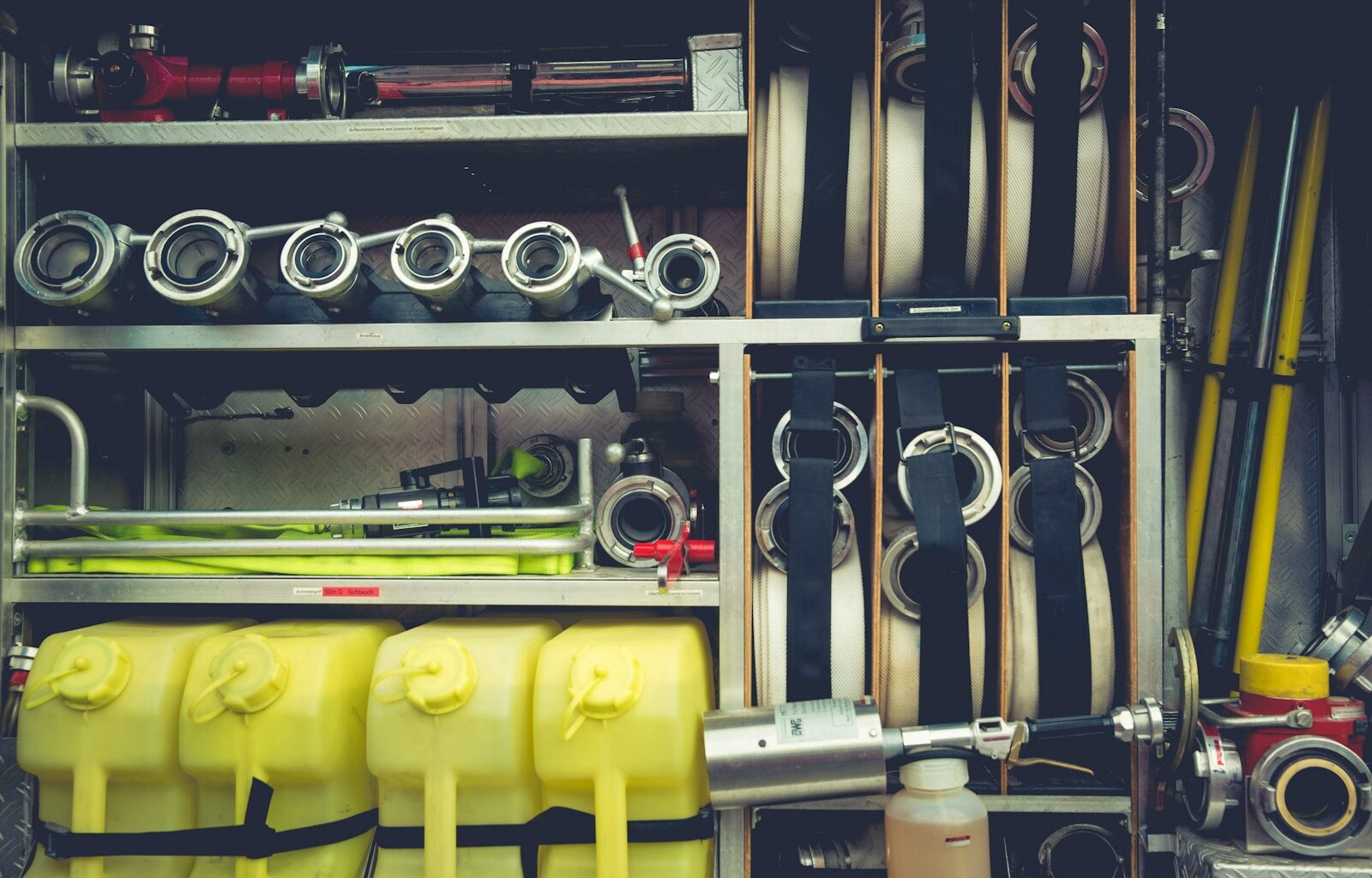Knowing how to prevent and handle fires in your home is important as a homeowner. Fires can devastate and cause extensive damage to your property, putting your family’s safety at risk. Taking the necessary precautions and following the right safety tips can reduce the risk of fires and keep your family safe.
Fire Safety Basics is the first step in protecting your home from fires. You should know how to install smoke alarms, create an escape plan, and use fire extinguishers. You should also know safe electrical practices and how to handle kitchen fires. It’s important to use fire-resistant materials in home construction and to educate your family members about fire safety.
By following these Fire Safety Tips, you can protect your home and family from the dangers of fires. Regular maintenance and inspections and seasonal fire safety tips can also help reduce the risk of fires in your home. With the right knowledge and preparation, you can keep your family safe and protect your home from the devastating effects of fires.
Key Takeaway
- Fire Safety Basics is crucial for protecting your home and family from fires.
- Installing smoke alarms, creating an escape plan, and using fire extinguishers are essential fire safety practices.
- Regular maintenance and inspections and seasonal fire safety tips can help reduce the risk of fires in your home.
Fire Safety Basics
Fire safety is an essential aspect of homeownership that you should never overlook. Fires can happen anytime, anywhere, and without warning. Therefore, it’s crucial to understand the basics of fire safety to protect yourself, your family, and your property from harm.
Types of Fires
Fires can be classified into five categories: Class A, Class B, Class C, Class D, and Class K. Each fire class requires a different type of extinguisher.
- Class A fires involve ordinary combustibles like wood, paper, and cloth.
- Class B fires involve flammable liquids and gases, such as gasoline and propane.
- Class C fires involve electrical equipment, such as appliances and wiring.
- Class D fires involve combustible metals, such as magnesium and titanium.
- Class K fires involve cooking oils and fats, such as in a kitchen.
Fire Prevention Principles
Fire prevention is the best way to ensure your safety and protect your home. Here are some fire prevention principles that you should follow:
- Install smoke detectors on every level of your home and test them regularly.
- Keep flammable materials away from heat sources, such as stoves and heaters.
- Never leave cooking food unattended.
- Don’t overload electrical outlets or extension cords.
- Keep a fire extinguisher in an easily accessible location.
- Have an evacuation plan in place and practice it with your family.
By following these fire safety basics, you can minimize the risk of a fire in your home and ensure that you’re prepared in an emergency.
Installing Smoke Alarms
Smoke alarms are essential for fire safety in any home. They can detect smoke and alert you to a fire, giving you time to evacuate safely. Here are some tips for installing smoke alarms in your home:
Choosing the Right Type
There are two types of smoke alarms: ionization and photoelectric. Ionization alarms are better at detecting flames, while photoelectric alarms detect smoldering fires. For maximum protection, having both types in your home is recommended. You can also choose to have interconnected smoke alarms, which means that if one alarm goes off, all the alarms in your home will sound.
Proper Placement
Smoke alarms should be placed on every level of your home, including the basement and attic. They should also be installed inside and outside sleeping areas and in every bedroom. Install smoke alarms on the ceiling or the wall, but not close to the corners. If you have a high ceiling, install the smoke alarm within 3 feet of the highest point. Avoid installing smoke alarms near windows, doors, or vents, as drafts can affect their performance.
Maintenance and Testing
Once you have installed smoke alarms, it is important to maintain and test them regularly. Test your smoke alarms at least once a month by pressing the test button. Replace the batteries at least once a year or when the low battery warning chirps. It is also recommended that you replace your smoke alarms every 10 years or earlier if they are not functioning properly. Clean your smoke alarms by vacuuming them regularly to remove dust and debris.
By following these tips, you can ensure that your home is equipped with properly installed and maintained smoke alarms, which can help keep you and your family safe in the event of a fire.
Safe Electrical Practices
As a homeowner, you should prioritize electrical safety to protect yourself, your family, and your property. Here are some safe electrical practices you should follow:
Avoiding Overloaded Circuits
One of the most common causes of electrical fires is overloaded circuits. Overloading can occur when too many appliances or devices are plugged into one outlet or circuit. To avoid this, distribute your electrical load evenly across different outlets and circuits in your home. If you’re unsure whether a circuit is overloaded, check the circuit breaker or fuse box. If the circuit keeps tripping or the fuse keeps blowing, it’s a sign that the circuit is overloaded.
Regular Inspection of Wires
Regular inspection of wires is essential to ensure that your electrical system is safe and functional. Look for signs of frayed or damaged wires, loose connections, or wear and tear. If you notice any of these signs, turn off the power to that circuit and call a licensed electrician to fix the problem. Don’t try to fix electrical problems yourself, as this can be dangerous and lead to further damage to your electrical system.
Following these safe electrical practices can help prevent electrical fires and ensure that your home’s electrical system is safe and functional.
Creating an Escape Plan
As a homeowner, having a fire escape plan in case of an emergency is important. This plan should include designing escape routes and regularly practicing drills.
Designing Escape Routes
When designing your escape routes, consider all possible exits from each room in your home. This may include doors, windows, and a fire escape ladder if you live in a multi-story home. Ensure all exits are easily accessible and not blocked by furniture or other objects.
It’s also important to have a designated meeting place outside your home where everyone can gather after escaping. This could be a neighbor’s house, a tree, or a lamppost. Ensure that everyone in your household knows where the meeting place is and that it’s included in your escape plan.
Practicing Drills Regularly
Having an escape plan is not enough. You and your household members should practice fire drills regularly to ensure everyone knows what to do in an emergency. Set off the smoke alarm and go through the motions of escaping your home as quickly and safely as possible.
Ensure that everyone knows the escape routes and the designated meeting place. Practice drills during the day and at night to prepare for any scenario.
By designing escape routes and practicing drills regularly, you can ensure that you and your household members are prepared in case of a fire emergency. Many people forget that updating their escape plan as needed and ensuring everyone knows what to do in an emergency is important yet simple.
Using Fire Extinguishers
Fire extinguishers are an essential tool for every homeowner to have in a fire emergency. Knowing how to use a fire extinguisher correctly can make all the difference in preventing a small fire from turning into a major disaster.
Types and Uses
There are different types of fire extinguishers, and each one is designed to put out a specific type of fire. Knowing which fire extinguisher to use for a particular fire is essential. The following are the five types of fire extinguishers:
- Class A: This type of fire extinguisher is designed to put out fires that involve ordinary combustibles such as wood, paper, and cloth.
- Class B: This type of fire extinguisher is designed to put out fires that involve flammable liquids such as gasoline, oil, and grease.
- Class C: This type of fire extinguisher is designed to put out fires that involve electrical equipment such as appliances, wiring, and circuit breakers.
- Class D: This type of fire extinguisher is designed to put out fires that involve flammable metals such as magnesium, titanium, and sodium.
- Class K: This type of fire extinguisher is designed to put out fires that involve cooking oils and fats commonly found in kitchens.
Operation Techniques
Knowing how to operate a fire extinguisher is as important as knowing which type to use. The following are the steps to follow when using a fire extinguisher:
- Pull the pin: The first step is to pull the pin at the top of the fire extinguisher. This pin releases the locking mechanism, allowing you to discharge the extinguisher.
- Aim at the base of the fire: Aim the fire extinguisher’s nozzle at the base of the fire, not the flames. This will help extinguish the fire at its source.
- Squeeze the handle: Squeeze the handle or lever of the fire extinguisher to discharge the extinguishing agent. Do not release the handle until you have completely extinguished the fire.
- Sweep from side to side: Finally, sweep the fire extinguisher’s nozzle from side to side, covering the entire fire area. Keep the extinguisher aimed at the base of the fire and move it from side to side until the flames are extinguished.
Handling Kitchen Fires
Kitchen fires are one of the most common types of fires that can occur in a home. Knowing how to prevent and handle them is important to protect yourself and your family.
Preventing Cooking Fires
The best way to prevent cooking fires is to never leave your cooking unattended. Keep a close eye on your food, especially when frying, grilling, or broiling. Turn off the stove or oven if you need to leave the kitchen. Also, keep flammable objects such as pot holders, towels, and curtains away from the stove.
Another important tip is to be careful with oil. When cooking with oil, use a high-pitched pan to prevent splatters. If you see smoke or the oil boiling, turn off the heat and cover the pan with a lid. Do not try to move the pan or throw water on it, as this can make the fire worse.
What to Do in Case of a Kitchen Fire
If a fire does break out in your kitchen, it is important to act quickly and safely. Follow these steps:
- Turn off the heat source. If the fire is on the stove, turn off the burner. Turn off the heat and keep the door closed if it is in the oven.
- Smother the fire. If the fire is small and contained, use a fire extinguisher or baking soda to put it out. If you don’t have a fire extinguisher, use a lid to cover the pan and smother the flames. Do not use water, flour, or sugar to put out a grease fire, as this can worsen it.
- Get out and call for help. If the fire is too big or you cannot control it, leave the house and call 911 immediately. Do not try to fight the fire yourself.
Remember, the best way to handle a kitchen fire is to prevent it from happening in the first place. Following these tips and being cautious in the kitchen can protect your home and family from fires.
Fire-Resistant Materials in Home Construction
Fire safety should be a top priority when building or renovating your home. One of the best ways to ensure your home is fire-resistant is to use fire-resistant materials in your construction.
Choosing Materials
Choosing the right materials for your home is essential to ensure that it is fire-resistant. Some materials are more fire-resistant than others, so choosing the right ones is important. Here are some materials that you can use to make your home fire-resistant:
- Concrete: Concrete is an excellent fire-resistant material. It is non-combustible and can withstand high temperatures. It is also durable and requires little maintenance.
- Brick: Brick is another excellent fire-resistant material. It is non-combustible and can withstand high temperatures. It is also durable and requires little maintenance.
- Metal: Metal is a good fire-resistant material. It is non-combustible and can withstand high temperatures. It is also durable and requires little maintenance.
- Gypsum: Gypsum is a good fire-resistant material. It is non-combustible and can withstand high temperatures. It is also inexpensive and easy to install.
- Fiber-cement: Fiber-cement is a good fire-resistant material. It is non-combustible and can withstand high temperatures. It is also durable and requires little maintenance.
Benefits
Using fire-resistant materials in your home construction has many benefits. Here are some of the benefits:
- Safety: Fire-resistant materials can help prevent fires from spreading and reduce the risk of injury or death in a fire.
- Durability: Fire-resistant materials are often more durable than other materials. They can withstand high temperatures and are less likely to be damaged by fire or smoke.
- Insurance: Using fire-resistant materials in your home construction can help reduce your insurance premiums. Insurance companies often offer discounts for homes that are built with fire-resistant materials.
- Resale Value: Homes built with fire-resistant materials often have a higher resale value. This is because they are considered safer and more durable than homes not built with fire-resistant materials.
Educating Family Members
Fire safety is a crucial aspect of owning a home, and educating your family members on how to prevent fires and what to do in an emergency is important. Here are some tips for teaching your loved ones about fire safety.
Teaching Children About Fire Safety
Children are especially vulnerable to fires, so teaching them about fire safety from an early age is important. Start by explaining the dangers of fire in a way that they can understand and encourage them to ask questions. Ensure they know what smoke detectors sound like and what to do if they hear the alarm.
Create a fire escape plan together and practice it regularly. Teach them to crawl low under smoke and to feel doors for heat before opening them. Make sure they know how to call 911 in case of an emergency.
Fire Safety for Pets
Pets are also at risk during a fire, and it’s important to have a plan in place to keep them safe. Ensure your pets are included in your fire escape plan and practice evacuating with them. Keep leashes and carriers near the exit if you need to evacuate your home quickly.
Be aware of potential fire hazards to your pets, such as knocking over candles or chewing electrical cords. Keep these hazards out of reach, and never leave pets unattended near an open flame.
By educating your family members on fire safety, you can help prevent fires and keep everyone safe in case of an emergency. Regularly review your fire safety plan and practice fire drills with your loved ones.
Regular Maintenance and Inspections
As a responsible homeowner, you should prioritize regular maintenance and inspections of your home’s heating systems, chimneys, and fireplaces to ensure they function properly and safely. Below are some tips to help you maintain these systems:
Heating Systems
Heating systems are essential, especially during the cold months. However, they can also be a fire hazard if not properly maintained. Here are some tips to keep your heating system safe:
- Have your heating system inspected and serviced by a licensed professional at least once a year.
- Replace air filters regularly to prevent dust and debris buildup.
- Keep flammable materials away from your heating system, such as curtains, furniture, and papers.
- Install carbon monoxide detectors in your home to detect leaks from your heating system.
Chimneys and Fireplaces
Chimneys and fireplaces are cozy and inviting but can also be dangerous if improperly maintained. Here are some tips to keep your chimney and fireplace safe:
- Have your chimney inspected and cleaned by a professional sweep at least once a year.
- Use only dry, seasoned wood in your fireplace to prevent creosote buildup in your chimney.
- Keep the area around your fireplace clear of flammable materials, such as rugs and furniture.
- Use a fireplace screen to prevent embers from escaping and starting a fire.
Following these tips ensures that your heating systems, chimneys, and fireplaces are safe and functioning properly. Regular maintenance and inspections are key to preventing fires and keeping your home and family safe.
Seasonal Fire Safety Tips
Holiday Decorations
The holiday season is a time for joy and celebration but can also be a time of increased fire risk. Decorations such as Christmas trees, lights, and candles can all pose a threat if not handled properly. Here are some tips to keep your home safe during the holidays:
- Choose a fresh Christmas tree and keep it well-watered. Dry trees can easily catch fire.
- Keep your tree away from heat sources such as fireplaces, radiators, and heaters.
- Inspect your holiday lights for any damage before use. Replace any frayed or damaged cords.
- Don’t overload your electrical outlets. Use a power strip with a built-in circuit breaker.
- Blow out candles before leaving the room or going to bed.
Outdoor Grilling
Summer is a time for outdoor barbecues and grilling, but it’s important to remember that grilling can also be a fire hazard. Follow these tips to ensure a safe and enjoyable grilling experience:
- Keep your grill at least 10 feet from your house or other structures.
- Clean your grill regularly to prevent grease buildup, which can easily ignite.
- Check your propane tank for leaks before use. You can do this by applying a solution of soap and water to the tank and watching for bubbles.
- Never leave your grill unattended while in use.
- Keep a fire extinguisher nearby in case of emergency.
Sources & References
- https://www.redcross.org/get-help/how-to-prepare-for-emergencies/types-of-emergencies/fire.html
- https://www.nfpa.org/education-and-research/home-fire-safety/safety-tip-sheets
- https://www.nationwide.com/lc/resources/home/articles/home-fire-safety
- https://www.safehome.org/resources/fire-prevention-guide/








